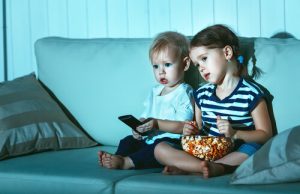7 Movies to Help Children Develop Emotional Intelligence

Emotional intelligence is the ability to control, manage and transmit emotions in a social context. When applied correctly, it benefits social interaction and reduces tension created by personal interest.
Over the history of cinema, various interesting films have been made that help children develop emotional intelligence.
There are numerous methodologies that help children learn and develop emotional intelligence. One fun and effective method is through movies, specifically those that focus on handling emotions.
In today’s article, we want to share a list of quality films that are not only well made, but that also share a deep message.
7 movies that help children develop emotional intelligence
Inside Out
This movie is by far one of the best films for teaching children about emotional intelligence. The animated motion picture represents various emotions that a 9-year-old girl experiences.
Happiness, sadness, disgust, fear and anger accompany young Riley in the new life that her parents have imposed. Throughout the movie, viewers can see how Riley experiences different emotions, handles situations, and adapts to change.
Up
This film tells the story of an older man and a young boy who help one another pursue their dreams. The movie not only addresses the issues of emotion, but also attitude. Each character represents a different way of viewing life. In other words, pessimism versus optimism.
The movie portrays difficult experiences for the characters and shows the way each individual handles them. We see grief, disappointment and loneliness, and at the same time, the emotional skills of resilience, perseverance and humility.

Dumbo
A classic Disney cartoon, this movie narrates the story of a small elephant living in the circus. Dumbo doesn’t fit into any spectacle and is a constant target of bullying by his circus mates. What’s more, he has been separated from his mother, who had always tried to protect him.
Humility is the connecting tissue in this story, making the spectator experience a range of emotions. It’s a great film for children and adults alike, with a strong message for everyone.
WALL-E
This story is unique in that it demonstrates emotions through a robot. Wall-E is a trash compactor that has been left alone on earth. With the arrival of EVA, a “heartless” robot, WALL-E connects with happiness, hope and anticipation.
This movie speaks about the power of love and its transformation. It also addresses social concepts such as freedom, independence, and the importance of accepting others for who they are.
Frozen
Here we have a film that directly addresses the power of emotions and their effects. The movie tells the story of two royal sisters who grow apart due to a misunderstanding.
Elsa, the older sister, must learn to handle her emotions in order to control her power. When she loses control of her emotions, she freezes the entire town.
The moral of the story has to do with humility and the importance of respecting others. Once again, the power of love and resilience arise as the key to success.

Spirited Away
The value of family is a key theme in this movie. As in many movies that help children learn about emotional intelligence, the main character has a hard time controlling her emotions. This leads her to encounter unpleasant and unexpected experiences.
Spirited Away doesn’t escape from the situation. Given her temperament, she’s forced to live an adventure with spirits and ghosts. She’s no longer her mom and dad’s daughter, but rather a person who is responsible for herself. Her experiences lead her through states of loneliness, anguish and sadness.
E.T.
This classic American film deals with an extraterrestrian who becomes friends with a child on earth. E.T.’s only desire is to return home, and the young boy only wants to help him. This movie is another example of how to develop emotional intelligence in children.
E.T. represents pure emotions, goodness and solidarity. The movie also deals with the effects of divorce within a family and how this impacts children’s emotions.
Emotional intelligence is the ability to control, manage and transmit emotions in a social context. When applied correctly, it benefits social interaction and reduces tension created by personal interest.
Over the history of cinema, various interesting films have been made that help children develop emotional intelligence.
There are numerous methodologies that help children learn and develop emotional intelligence. One fun and effective method is through movies, specifically those that focus on handling emotions.
In today’s article, we want to share a list of quality films that are not only well made, but that also share a deep message.
7 movies that help children develop emotional intelligence
Inside Out
This movie is by far one of the best films for teaching children about emotional intelligence. The animated motion picture represents various emotions that a 9-year-old girl experiences.
Happiness, sadness, disgust, fear and anger accompany young Riley in the new life that her parents have imposed. Throughout the movie, viewers can see how Riley experiences different emotions, handles situations, and adapts to change.
Up
This film tells the story of an older man and a young boy who help one another pursue their dreams. The movie not only addresses the issues of emotion, but also attitude. Each character represents a different way of viewing life. In other words, pessimism versus optimism.
The movie portrays difficult experiences for the characters and shows the way each individual handles them. We see grief, disappointment and loneliness, and at the same time, the emotional skills of resilience, perseverance and humility.

Dumbo
A classic Disney cartoon, this movie narrates the story of a small elephant living in the circus. Dumbo doesn’t fit into any spectacle and is a constant target of bullying by his circus mates. What’s more, he has been separated from his mother, who had always tried to protect him.
Humility is the connecting tissue in this story, making the spectator experience a range of emotions. It’s a great film for children and adults alike, with a strong message for everyone.
WALL-E
This story is unique in that it demonstrates emotions through a robot. Wall-E is a trash compactor that has been left alone on earth. With the arrival of EVA, a “heartless” robot, WALL-E connects with happiness, hope and anticipation.
This movie speaks about the power of love and its transformation. It also addresses social concepts such as freedom, independence, and the importance of accepting others for who they are.
Frozen
Here we have a film that directly addresses the power of emotions and their effects. The movie tells the story of two royal sisters who grow apart due to a misunderstanding.
Elsa, the older sister, must learn to handle her emotions in order to control her power. When she loses control of her emotions, she freezes the entire town.
The moral of the story has to do with humility and the importance of respecting others. Once again, the power of love and resilience arise as the key to success.

Spirited Away
The value of family is a key theme in this movie. As in many movies that help children learn about emotional intelligence, the main character has a hard time controlling her emotions. This leads her to encounter unpleasant and unexpected experiences.
Spirited Away doesn’t escape from the situation. Given her temperament, she’s forced to live an adventure with spirits and ghosts. She’s no longer her mom and dad’s daughter, but rather a person who is responsible for herself. Her experiences lead her through states of loneliness, anguish and sadness.
E.T.
This classic American film deals with an extraterrestrian who becomes friends with a child on earth. E.T.’s only desire is to return home, and the young boy only wants to help him. This movie is another example of how to develop emotional intelligence in children.
E.T. represents pure emotions, goodness and solidarity. The movie also deals with the effects of divorce within a family and how this impacts children’s emotions.
All cited sources were thoroughly reviewed by our team to ensure their quality, reliability, currency, and validity. The bibliography of this article was considered reliable and of academic or scientific accuracy.
- Fernández-Berrocal, P., & Extremera Pacheco, N. (2009). La inteligencia emocional y el estudio de la felicidad. Revista interuniversitaria de formación del profesorado, 23(3). https://www.redalyc.org/html/274/27419066006/
- Goleman, D. (2018). Inteligencia emocional. Editorial kairos.
- Rangel, A. E. N. (2014). Inteligencia emocional. Salud vida, 1.
- Trujillo Flores, M. M., & Rivas Tovar, L. A. (2005). Orígenes, evolución y modelos de inteligencia emocional. Innovar, 15(25), 9-24. http://www.scielo.org.co/scielo.php?pid=S0121-50512005000100001&script=sci_abstract&tlng=fr
- Peter Del Vecho, John Lasseter y Chris Buck, Jennifer Lee. (2013). Frozen. Estados Unidos: Walt Disney Productions y Walt Disney Animation Studios.
- Jonas Rivera y Pete Docter, Ronnie del Carmen. (2015). Inside Out. Estados Unidos: Pixar Animation Studios, Walt Disney Pictures.
- Jonas Rivera, John Lasseter, Andrew Stanton y Pete Docter, Bob Peterson. (2009). Up. Walt Disney Pictures, Pixar Animation Studios.
- Walt Disney y Ben Sharpsteen. (1941). Dumbo. Estados Unidos: Walt Disney Productions.
- David McCarthy y Andrew Stanton. (2008). Wall-E. Estados Unidos: Pixar, Walt Disney Pictures.
- Toshio Suzuki y Hayao Miyazaki. (2001). El viaje de Chihiro. Japón: Studio Ghibli.
- Katy Emde y Steven Spielberg. (1982). E.T.: el extraterretre. Estados Unidos: Universal Pictures, Amblin Entertainment.
This text is provided for informational purposes only and does not replace consultation with a professional. If in doubt, consult your specialist.








